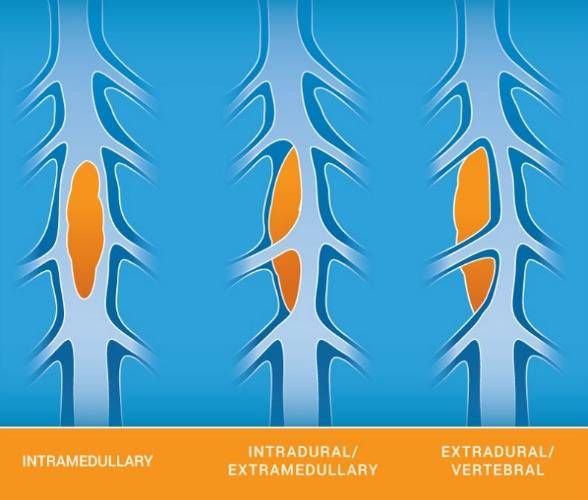Intramedullary tumors, like all spinal cord tumors, can cause back pain and neurological symptoms like muscle weakness, tingling and loss of sensation. Symptoms like these can progress to the point that they are devastating if left untreated.
If your doctor has diagnosed you with an intramedullary tumor, the next step is to decide how to treat it. Treatment options include monitoring the tumor, radiation, and surgical removal. Your surgeon will decide what option is best based on the location and size of the tumor.
Overview of Intramedullary Tumors
Intramedullary tumors are just one type of spinal cord tumor. By looking at how they stack up against other types of spinal cord tumors, you can gain a more comprehensive view of your condition.
Spinal cord tumors are defined by their position relative to the dura mater, which is a thick membrane that protects the brain and spinal cord. Tumors can be either extradural, meaning they exist outside of the dura mater, or intradural, meaning they exist within the dura mater.
Extradural tumors are more common and they are usually the result of cancer metastasis, meaning that they do not begin inside the spinal cord; they develop elsewhere and then move to the spine.
Unlike extradural tumors, intradural tumors are usually primary tumors, meaning they develop in a certain location and stay there. Because their exact location can vary, they are further divided into two categories: extramedullary and intramedullary. Extramedullary tumors are inside the dura mater but outside of the spinal cord itself. They might develop from nerve roots or from the inside surface of the dura mater. Intramedullary tumors, on the other hand, come from the cells of the spinal cord itself.
Most intramedullary tumors are astrocytomas and ependymomas, with astrocytomas being more common in children and ependymomas appearing more frequently in adults. These tumors are typically benign and usually occur in the cervical spine (near the neck).
 Treatment Options
Treatment Options
Surgery
Because intramedullary tumors grow from and are directly connected to the sensitive cells of the spinal cord, it can be a challenge to surgically remove them. However, as medical technology progresses, surgeons are finding easier ways to safely remove intramedullary tumors while preserving as much neurological function as possible. As a result, surgical removal is usually the preferred treatment option.
There are some cases when surgery isn’t a good option. For example, a tumor might be connected to surrounding tissue in such a way that attempting surgical removal would pose too great a risk. You may also have pre-existing conditions that make surgery a less viable option.
Monitoring
If your tumor is small and doesn’t cause symptoms, monitoring it may be a good option. Monitoring a tumor comes with several pros and cons. For example, it’s safe way to avoid surgery. An untreated tumor, however, carries the risk of sudden growth, which can necessitate surgery. For this reason, surgeons will sometimes recommend surgery as a preventative measure to avoid future complications.
Radiation
Surgery is the preferred treatment option, however radiation has a role in treating tumors that are not able to be removed completely with surgery. Radiation is one such treatment and it consists of using concentrated beams of radiation to disrupt the function of tumor cells and shrink the tumor. Radiation is generally not used on its own; it’s more often used as a supplement to surgery to ensure that the area around the resected tumor is free of tumor cells.
Chemotherapy
Chemotherapy has no established role in treating most intramedullary tumors, however, If your tumor is the result of metastasis, which is cancer that has spread from another part of the body, chemotherapy is a potentially effective treatment.
How to Choose a Treatment
There are several important factors that determine which treatment is best for you and most of them relate to the details of your intramedullary tumor. If your tumor is small, slow-growing and poses no pressing threat to your health, the best choice may simply be to leave it alone and monitor it. Larger and/or faster-growing intramedullary tumors are more likely to require surgery.
If you are sufficiently healthy and your tumor’s size and location makes it treatable with surgery, then surgery is probably your best choice. There are some common side effects that you should consider before you schedule an operation. Intramedullary tumor surgery involves opening the back of spinal cord, which almost always involves some degree of impairment of the nerves that subserve sensation or balance. While this is an unfortunate side-effect of surgery, most find it preferable to the risks associated with letting a tumor grow untreated.
It’s also important to know that your doctor may recommend supplementary treatments to ensure that your condition will improve to the fullest extent possible. Radiation therapy is often used in addition to surgery to treat intramedullary tumors. If the tumor is the result of metastatic cancer, your doctor may also prescribe chemotherapy; surgical resection alone will not properly treat metastatic cancer.
The best way to decide which treatment is best for you is to carefully consider the details of your condition and discuss them with your doctor.
Overview of Recovery
After your surgery, you will likely be kept in bed for a day or two to aid wound healing. Then, with the help of nursing staff and a physical therapist, you will begin exercises to restore your independence. You will transition from IV to oral pain medication. The next few days will determine whether your are discharged to your home or not. Most patients who have had intramedullary tumor surgery require a short stay at an in-patient rehabilitation facility. Once you have demonstrated that you can eat, walk and use the restroom independently, you will be discharged home.
Your body will heal from the effects of the surgery itself after three or four weeks. Beyond that point, your recovery depends on the extent of your neurological deficits. It can take a year or two to maximize your neurological recovery. In most cases, issues of strength, sensation, and balance caused by these tumors will persist to a degree, even after recovery. Talk with your doctor to understand your condition and what expectations to set for your recovery.
Final Thoughts
Intramedullary tumors come in various shapes, sizes and locations. You can use the information in this guide to educate yourself and form questions for your next medical consultation.


 Treatment Options
Treatment Options